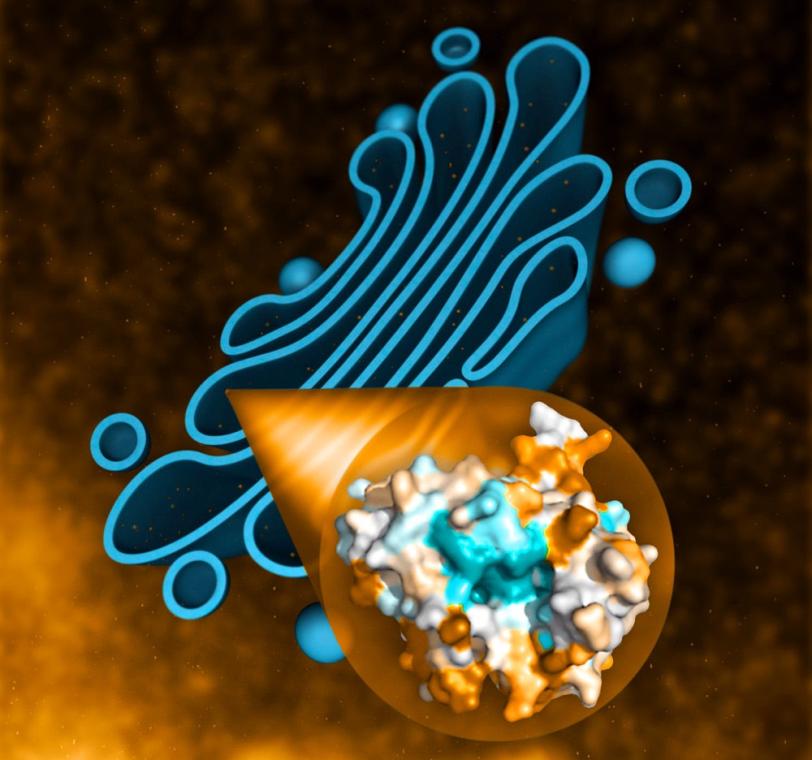SLAC Study Reveals Active Site of Enzyme Linked to Stuttering
Scientists from the Joint Center for Structural Genomics (JCSG) at SLAC National Accelerator Laboratory have determined the 3-D structure of the chemically active part of an enzyme involved in stuttering.
By Glennda Chui
Scientists from the Joint Center for Structural Genomics (JCSG) at SLAC National Accelerator Laboratory have determined the 3-D structure of the chemically active part of an enzyme involved in stuttering.
While the discovery is not likely to lead to a cure for stuttering any time soon, it is welcome news to scientists who have been studying this enzyme, known as "uncovering enzyme" or UCE, for decades. Not only does UCE play a role in the type of persistent stuttering that is passed down in families, but it’s also an important part of the system that breaks down and recycles unwanted molecules in our cells. Knowing its 3-D structure will aid studies of all these systems, and of the health problems that result when they malfunction.
A team led by SLAC’s Debanu Das reported the finding April 9 in the Journal of Biological Chemistry. Das is a structural biologist and protein crystallographer at SSRL, the Stanford Synchrotron Radiation Lightsource, and a member of the JCSG, a multi-institute consortium that rapidly screens proteins coming out of gene mapping projects to determine their structure and function. The JCSG is part of the Protein Structure Initiative funded by the National Institute of General Medical Sciences, and involves 10 scientists at SSRL.
"We go after interesting proteins for which nothing much is known, try to solve their structure and, based on that structure, try to understand what they're doing in the cell and what they're related to," Das said.
At SSRL, researchers aim powerful X-ray beams at crystallized samples of protein, creating patterns that reveal the protein’s 3-D structure. They analyze the structure to determine the protein’s function, and then scour the scientific literature to find scientists who might benefit from this information.
In this case, Das and his colleagues were working on the structure of DUF2233, a protein taken from one of the microbes that inhabit the human gut. Scanning protein databases and scientific reports, they learned that members of this new protein family were found in thousands of bacteria and in some viruses, but had only one representative in humans – UCE. "The microbe and human forms were not identical, but they were obviously related," Das said.
They also learned that scientists had been studying UCE for decades. It plays a key role in the functioning of lysosomes, cellular sacs full of digestive enzymes that break down bacteria, viruses and worn-out cell parts for recycling. When this recycling process goes awry, the result can be rare metabolic diseases such as Tay-Sachs and Gaucher, which often kill affected children by their early teens. And three years ago, researchers discovered that three mutations in UCE itself were linked to persistent stuttering that is passed down in families. It is thought, but not yet proven, that these mutations may impair the functioning of critical neurons involved in speech.
Das contacted Stuart Kornfeld, a hematologist at Washington University School of Medicine in St. Louis who has been working on UCE and its role in the workings of lysosomes for three decades, and they agreed to collaborate on further studies.
Working from the structure of microbial DUF2233, Das created a computer model that predicted the structure of the same region in human UCE. It showed a cavity on the surface of UCE that appears to be the “active site” where the enzyme brings other chemicals together and induces them to react with each other, a process known as catalysis.
With that model in hand, Kornfeld and other collaborators created various mutations in UCE to see what effect they had on the enzyme’s function. These experiments verified that Das had indeed identified the enzyme’s active site.
"This study by Debanu was the most important advance we've had in all these years," said Kornfeld, who is a co-author of the resulting paper. "We had no idea at all about what part of the enzyme was involved in its catalytic function."
Dennis Drayna, a human geneticist at the National Institute on Deafness and Other Communication Disorders whose team discovered the stuttering-linked mutations, said lack of knowledge about the structure and function of UCE had hampered studies of its effects.
"The reason this is so interesting to us is because many of the biochemical details of the nature of the UCE have been really quite obscure," he said. "It has been something of a black box. It's a singleton in all of the human genome, as far as we can tell."
While the three UCE mutations account for only 10 percent of persistent stuttering that runs in families, which in turn make up half of the total cases, that translates to about 3 million people worldwide, Drayna added. And while none of the stuttering mutations discovered so far occur within the cavity of the enzyme’s active site, this does not mean they would not have an impact on its chemical function, since pretty much every part of the protein is involved, in some fashion, in its work.
Paper co-author Ashley Deacon, a structural biologist and head of the Structural Genomics Division at SSRL, said scientists there are continuing to probe the structure of other parts of UCE, outside the active site.
"The whole molecule probably would not crystallize – often human proteins are rather big, with a lot of flexible regions – but we can do a single domain at a time," he said. "We’ll see how far we can get."
Other study co-authors include SSRL’s Hsiu-Ju Chiu and Mitchell D. Miller and researchers from the Genomics Institute of the Novartis Research Foundation, The Scripps Research Institute, Sanford-Burnham Medical Research Institute and the Center for Research in Biological Systems at University of California-San Diego, all in San Diego, Calif., which collaborate with SSRL as part of the JCSG.
